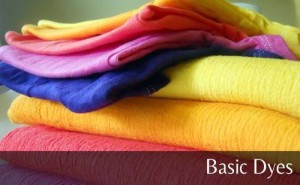 Dyes have been in use as colorants since ancient times and have wound their way in a number of industrial and commercial applications. Fabricated dyes are known as synthetic dyes and basic dyes forms a part of this synthetic dye class. One of the most popularly used dye in coloring of paper and acrylic fibers, basic dyes are renowned for their brightness and powerful coloring abilities.
Dyes have been in use as colorants since ancient times and have wound their way in a number of industrial and commercial applications. Fabricated dyes are known as synthetic dyes and basic dyes forms a part of this synthetic dye class. One of the most popularly used dye in coloring of paper and acrylic fibers, basic dyes are renowned for their brightness and powerful coloring abilities.
The naming procedure of this dye adheres to a certain pattern. The shade name is preceded by the term ‘basic’ and is followed by a number; for example, basic red 9 or basic brown 4 or basic green 4 and so on. None of the names are related in any manner nor do they have common properties. In fact, the naming procedure of all other types of dyes also follow a specific pattern, like for direct dyes the names include the likes of direct black 22, direct orange 26, direct blue 151 and so on. The procedure is very pragmatic as it has a definite sequence involved. The names offer color and functional data on the dye and do not express the dye’s chemical attributes. Some of the codification may have unique names but the numbers may be the same yet the dyes are totally different from one another. For example, the above mentioned example of basic brown 4 and basic green 4; here both the dyes are not related in any form with one another.
Basic dyes offer ease of use and are widely used in a number of dyeing applications as well as printing tasks. Due to their brightness and wash-fastness they popularly go towards dyeing or hand-painting acrylic fibers. They are an important item in the leather dyeing and paper industry. They are a common feature for permanent dyeing of floors, counters, sinks, containers and a number of other items. However, they do not possess sufficient wash fastness for dyeing wool fibers effectively and as far as cotton fiber is concerned there is a need for a mordant as otherwise there is greater possibility of the dye fading faster on exposure to sunlight. Natural tannins of raffia, reeds, barks, grasses function as a mordant ensuring the use of basic dyes proficiently with these substances.
Like many other dyes, the toxic nature of this dye too has to be kept in mind and handling has to be done with utmost care and caution. It is in any case wiser for beginners to avoid handling this dye due to its hazardous nature. It is essential to adhere to each of the safety precautions and get the MSDS data before buying any kind of basic dye. All reputed basic dyes, disperse dyes, vat dyes, acid dyes, solvent dyes manufacturers and more readily offer the MSDS data. Those who do not provide the data need to be bypassed as any purchase from them can prove dangerous to the safety and health of the buyers. It is also always better to purchase these dyes in a paste or liquid form at all times if possible.
In any case, basic dyes like all other colorants will remain indispensable in a wide array of applications!